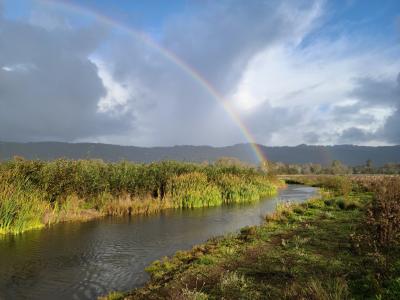Deep Roots — Celebrating 40 Years of Watershed Restoration
April 25 - 28, 2023
Modeling Salmonid Habitat: Stream State, Forest Conditions, and Future Climates
27 April 2023
1:30pm - 5:00pm
Session Coordinator:
Jonathan Halama, MPH, PhD, US EPA
This session’s focus is modeling of salmonid habitats from an aquatic stream reach to full watershed scale. Through the sharing of ideas and techniques we can further endeavors toward strengthening salmonid populations through the improvement of both the fish’s direct habitat and the surrounding area (riparian zone to the ridgeline) that all ultimately influence habitat conditions. Modeling efforts that help us further understand summer low flow conditions, mitigate winter flooding, reduce high summer stream temperatures, and improve cold-water refuges will be the focus of this session. A welcomed component will be any modeling techniques that possess the inclusion of climate change scenarios within the watershed evaluations to better understand and help mitigate how future climate conditions may impact the state of salmonid habitats. This session brings together people focused on modeling to share techniques and results to improve our understanding and enhance our watershed planning in hopes to maintain and improve critical salmonid habitat.
Jonathan Halama, MPH, PhD, US EPA
This session’s focus is modeling of salmonid habitats from an aquatic stream reach to full watershed scale. Through the sharing of ideas and techniques we can further endeavors toward strengthening salmonid populations through the improvement of both the fish’s direct habitat and the surrounding area (riparian zone to the ridgeline) that all ultimately influence habitat conditions. Modeling efforts that help us further understand summer low flow conditions, mitigate winter flooding, reduce high summer stream temperatures, and improve cold-water refuges will be the focus of this session. A welcomed component will be any modeling techniques that possess the inclusion of climate change scenarios within the watershed evaluations to better understand and help mitigate how future climate conditions may impact the state of salmonid habitats. This session brings together people focused on modeling to share techniques and results to improve our understanding and enhance our watershed planning in hopes to maintain and improve critical salmonid habitat.
Habitat Mosaics Support Variation in Salmon Foraging and Growth Potential Under Extreme Drought Conditions,
Rachael E. Ryan, PhD Candidate, University of California Berkeley
Rachael E. Ryan, PhD Candidate, University of California Berkeley
Modeling Benefits of Refuge Habitat for Salmonid Populations with InSTREAM,
Steven F. Railsback, PhD and PD, Lang Railsback & Associates
Steven F. Railsback, PhD and PD, Lang Railsback & Associates
Modeling the Influences of Diversions and Forest Practices on Streamflow in Streeter Creek near Laytonville, CA,
Julia Petreshen, Thomas Gast & Associates
Julia Petreshen, Thomas Gast & Associates
Habitat Modeling of Salmonid Movement and Survival in Degraded and Restored Watersheds,
Greg Blair, ICF
Greg Blair, ICF
Individual-based Modeling of Stage 0 Treatment on Juvenile Chinook,
Aleah Hahn, MS Student, Oregon State University
Aleah Hahn, MS Student, Oregon State University
Streams Across Lands (SAL): A New Stream Flow Modeling Method,
Jim Graham, PhD, Associate Professor, Cal Poly Humboldt
Predicting Fish Movement near Infrastructure in Different River and Reservoir Environments,
R. Andrew Goodwin, PhD, PE, Environmental Laboratory, U.S. Army Engineer Research and Development Center
R. Andrew Goodwin, PhD, PE, Environmental Laboratory, U.S. Army Engineer Research and Development Center

